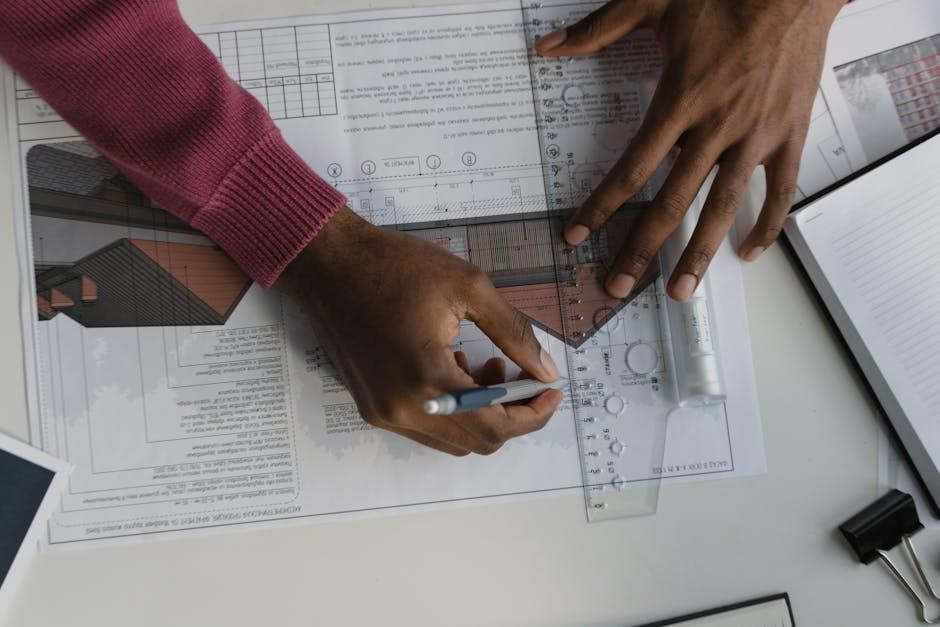The AS5202 specification outlines port dimensions, PSI ratings, and manufacturing standards, superseding MS33649. It is widely used in aerospace and defense, with specs available via McMaster and Idoc.pub.
Overview of AS5202 Specification
The AS5202 specification defines standardized port dimensions, PSI ratings, and manufacturing standards for hydraulic and fluid power systems. It supersedes the MS33649 specification and aligns with SAE J1926, ensuring compatibility and performance. The document outlines critical parameters for port design, material requirements, and fitting ends, making it essential for engineers and manufacturers. AS5202 is widely used in aerospace and defense applications, where reliability and precision are paramount. The specification is available through sources like McMaster and Idoc.pub, providing accessible engineering specs. It emphasizes quality assurance and compliance with industry standards, ensuring components meet rigorous testing and performance criteria. This specification is a cornerstone for modern engineering, offering a comprehensive guide for designing and integrating hydraulic ports in various systems.
Purpose of AS5202 Ports and PSI Rating
The AS5202 ports are designed for high-pressure hydraulic and fluid power systems, ensuring reliable performance in demanding applications. Their PSI ratings are specified to withstand operational pressures, guaranteeing safety and efficiency; The ports are engineered to facilitate secure connections in aerospace and defense systems, where durability and precision are critical. By standardizing port dimensions and pressure ratings, AS5202 ensures compatibility across various components and systems. This specification addresses the need for consistent performance in hydraulic systems, providing clear guidelines for manufacturers and engineers. The defined PSI ratings help in selecting appropriate components for specific applications, ensuring optimal system functionality and minimizing the risk of failure. This focus on pressure performance makes AS5202 ports indispensable in modern engineering and fluid power technologies.

Historical Context and Development
AS5202 evolved from MS33649 and SAE J1926, with AS5202A released in 2013. It standardizes port designs for aerospace, managed by SAE G-3/G-3B.
SAE J1926 and Its Supersession by AS5202
SAE J1926 was superseded by AS5202, which became the standard for port specifications in aerospace applications. AS5202 provides updated guidelines for port dimensions, PSI ratings, and manufacturing standards, ensuring compatibility and performance in modern systems. The transition from J1926 to AS5202 reflects advancements in engineering and material science, addressing the evolving needs of the aerospace and defense industries. While J1926 was foundational, AS5202 offers enhanced specifications, making it a critical reference for designers and manufacturers. Its widespread adoption is evident, with resources like McMaster and Idoc.pub offering accessible PDF downloads for engineering specs and port dimensions.
Evolution of AS5202 from MS33649
AS5202 evolved from the MS33649 specification, incorporating enhanced features and updated standards to meet modern aerospace demands. The transition aimed to improve port performance, dimensional accuracy, and material quality. Key advancements include refined PSI ratings, better corrosion resistance, and standardized fitting ends. AS5202 also aligns with global aerospace standards, ensuring interoperability across systems. While MS33649 laid the groundwork, AS5202 addresses contemporary challenges, offering a more robust and reliable solution. Its adoption is supported by resources like McMaster and Idoc.pub, which provide detailed PDF specifications for engineers. This evolution underscores the aerospace industry’s commitment to innovation and safety, making AS5202 a cornerstone of current port design and manufacturing practices.

Technical Specifications and Details
AS5202 specifies precise port dimensions, fitting ends, and pressure ratings, ensuring compatibility and performance. Material requirements and manufacturing standards are outlined to guarantee reliability and safety in aerospace applications.
Port Dimensions and Fitting Ends
The AS5202 specification provides detailed dimensions for ports and fitting ends, ensuring precise alignment and secure connections in hydraulic systems. Standardized thread forms, such as UNF or NPT, are specified for compatibility across applications. Fitting ends are designed with tight tolerances to minimize leakage and maximize performance under pressure. The document outlines acceptable surface finishes and chamfers for smooth installation and prolonged service life. Material compatibility is emphasized to prevent corrosion and ensure durability in harsh environments. These specifications enable manufacturers to produce interchangeable components, simplifying system integration and maintenance. Adherence to these standards is critical for optimal functionality in aerospace and fluid power systems.
Pressure Ratings and Performance Criteria
The AS5202 specification outlines maximum operating pressures for ports and fittings, ensuring reliability in high-pressure hydraulic systems. Pressure ratings vary based on port size, thread type, and application, typically ranging from 3000 to 5000 psi. Performance criteria include flow capacity, pressure drop, and burst pressure, which are critical for system design and safety. The document specifies minimum burst pressure requirements to ensure a safety margin above operational pressures. Materials and manufacturing processes are tested to meet these criteria, ensuring consistent performance under varying conditions. Compliance with these standards guarantees optimal functionality and durability in demanding environments, such as aerospace and industrial fluid power systems.
Material Requirements and Manufacturing Standards
The AS5202 specification defines strict material and manufacturing standards to ensure component reliability and durability. Port fittings must be constructed from high-strength materials, such as steel alloys, with specified chemical compositions and mechanical properties. The standard includes requirements for tensile strength, yield strength, and elongation to guarantee material integrity. Manufacturing processes must adhere to precise tolerances and surface finish specifications to maintain consistency. Additionally, heat treatment procedures are detailed to enhance material performance under stress. The document also outlines testing protocols to verify compliance with material and manufacturing criteria. These standards ensure that AS5202 components meet the rigorous demands of aerospace and hydraulic systems, providing long-term reliability and safety in operation.

Availability and Access to AS5202 Specs
AS5202 specifications are easily accessible via official SAE publications and authorized distributors like McMaster-Carr, ensuring engineers can obtain reliable, industry-standard documents for compliance and application.
Where to Find AS5202 Port Application/Engineering Specs
The AS5202 port application and engineering specifications can be sourced from official SAE publications and authorized distributors like McMaster-Carr. Additionally, platforms such as Idoc;pub provide accessible PDF documents containing detailed technical information. Engineers often rely on these resources to ensure compliance with industry standards. It is essential to verify the latest revision of the specification to align with current engineering practices. These sources offer comprehensive details on port dimensions, fitting ends, and performance criteria, making them indispensable for design and implementation. Always cross-reference multiple sources to ensure accuracy and completeness of the specifications.
McMaster and Idoc.pub as Key Sources
McMaster-Carr and Idoc.pub are two prominent platforms where engineers can access detailed AS5202 specifications. McMaster-Carr, a trusted supplier of industrial components, provides comprehensive technical documentation, including AS5202 port dimensions and material requirements. Their platform is user-friendly, allowing seamless access to PDF resources. Similarly, Idoc.pub serves as a valuable repository for AS5202 spec PDFs, offering downloadable files that cover port applications, pressure ratings, and manufacturing standards. Both sources are frequently updated, ensuring engineers have the most current information. These platforms are indispensable for professionals needing accurate and reliable data for design and implementation purposes.

Challenges and Considerations
The AS5202 spec PDF presents challenges, including limited availability of compliant fittings, lead times, and counterfeit risks. Design complexity and material sourcing further complicate implementation.
Availability of AS5202 Fittings
The availability of AS5202 fittings can be challenging due to limited production volumes and specialized manufacturing requirements. These fittings are designed for high-performance applications, often leading to longer lead times. Additionally, the niche demand for AS5202 components results in fewer suppliers, creating supply chain bottlenecks. Counterfeit products in the market pose risks, emphasizing the need for sourcing from verified manufacturers. The fittings’ complexity and precise tolerances require specialized tools, further limiting availability. Industries reliant on these components must plan procurement well in advance to mitigate delays. Collaboration with trusted suppliers is essential to ensure timely access to genuine AS5202 fittings, maintaining system performance and safety standards.
Common Issues in Sourcing AS5202 Components
Sourcing AS5202 components often presents challenges, including extended lead times due to specialized manufacturing processes. The limited number of certified manufacturers can create supply chain constraints, especially for high-volume orders. Additionally, the niche demand for these components leads to higher costs compared to standard parts. Counterfeit products are another concern, as they can compromise system performance and safety. Quality control inconsistencies among suppliers further complicate procurement efforts. Buyers must also navigate complex certification requirements to ensure compliance with industry standards. To address these issues, it is crucial to work with reputable suppliers and plan orders well in advance. Building strong supplier relationships and implementing rigorous quality checks can help mitigate these challenges effectively.

Certifications and Compliance
Certifications ensure AS5202 components meet strict industry standards, with SAE oversight guaranteeing quality and reliability. Compliance with aerospace regulations is non-negotiable, ensuring safety and performance in critical applications.
SAE G-3/G-3B Custodian and Revision History
The SAE G-3 committee serves as the custodian for the AS5202 specification, ensuring its integrity and relevance through periodic revisions. This committee, comprised of industry experts, reviews and updates the standard to reflect advancements in technology, materials, and application requirements. The revision history of AS5202 is meticulously documented, providing a clear timeline of changes and improvements. Each revision is based on feedback from manufacturers, users, and regulatory bodies, ensuring the specification remains aligned with industry needs. The custodian role involves maintaining consistency with other SAE standards while addressing emerging challenges in aerospace and defense applications. This structured approach guarantees that AS5202 remains a reliable and authoritative reference for hydraulic port design and performance.
Quality Assurance and Industry Standards
The AS5202 specification adheres to rigorous quality assurance protocols, ensuring compliance with global aerospace and defense standards. Manufacturers must follow strict testing and inspection procedures to verify material integrity, dimensional accuracy, and performance under various operating conditions. The standard emphasizes traceability of materials and components, as well as adherence to environmental and safety regulations. Regular audits and certifications are required to maintain compliance, ensuring that AS5202 fittings meet the highest industry benchmarks. By aligning with established aerospace standards, AS5202 promotes reliability and interoperability across systems, making it a cornerstone for modern hydraulic and fluid power applications. This focus on quality assurance ensures long-term durability and operational safety in critical systems.

Applications and Uses
The AS5202 specification is primarily used in aerospace and defense industries, particularly in hydraulic and fluid power systems, ensuring performance, safety, and reliability in applications.
Aerospace and Defense Applications
The AS5202 specification is widely utilized in aerospace and defense industries, where high-performance hydraulic and fluid power systems are critical. It serves as a standard for ports, fittings, and manifolds in aircraft, military vehicles, and defense equipment. These components are essential for systems requiring precise fluid control, such as landing gear, weapons systems, and missile guidance. The AS5202 spec ensures reliability, durability, and compatibility in harsh environments, making it a cornerstone for mission-critical applications. Its adoption across defense contractors and aerospace manufacturers underscores its importance in maintaining operational readiness and safety standards.
Hydraulic and Fluid Power Systems
The AS5202 specification plays a pivotal role in hydraulic and fluid power systems, ensuring components meet stringent performance and reliability standards. It defines the design, dimensions, and testing criteria for hydraulic ports and fittings, critical in high-pressure and high-flow applications. These systems rely on AS5202-compliant components to maintain efficiency, safety, and durability in industrial machinery, heavy equipment, and mobile hydraulics. The specification addresses flow rates, pressure ratings, and material compatibility, ensuring seamless integration within hydraulic circuits. Its guidelines are essential for avoiding fluid leakage, contamination, and system failure, making it a cornerstone for modern hydraulic engineering across industries like construction, agriculture, and manufacturing.

Installation and Maintenance
Proper installation ensures leak-free connections and system integrity. Use torque specs and compatible materials. Regularly inspect ports and fittings for wear or damage. Clean connections before assembly for optimal performance and longevity.
Best Practices for AS5202 Port Installation

Adhere to torque specifications to avoid over-tightening, which can damage threads or compromise sealing. Ensure all surfaces are clean and free of debris before assembly. Use compatible materials for port fittings to prevent corrosion or contamination. Properly align the port and fitting during installation to maintain structural integrity. Apply a thin, even layer of lubricant to threaded connections if specified. Avoid cross-threading by guiding components carefully. Tighten in a star pattern for even stress distribution. Inspect all connections post-installation for leaks or misalignment. Follow manufacturer guidelines for environmental considerations, such as temperature and pressure limits. Use calibrated tools to ensure accuracy during assembly. Document the installation process for future reference or maintenance needs. This ensures reliability and longevity in high-performance systems like aerospace applications.
Maintenance and Inspection Guidelines
Regularly inspect AS5202 ports for signs of wear, corrosion, or leakage. Perform visual checks for damage or contamination before and after use. Clean ports and fittings with approved solvents to remove debris or residue. Replace seals or gaskets if signs of degradation are present. Apply lubrication to moving parts as per manufacturer recommendations. Conduct pressure tests to ensure system integrity. Document all maintenance activities for traceability. Train personnel on proper inspection techniques to prevent human error. Use calibrated tools during inspections to ensure accuracy. Address any issues promptly to prevent system failure. Follow a scheduled maintenance plan tailored to the application’s operating conditions. Store unused ports in a clean, dry environment to prevent contamination. Refer to the AS5202 spec PDF for detailed procedures and intervals.

The AS5202 spec PDF is a critical standard in engineering, ensuring optimal performance and safety. Adhering to its guidelines is essential for system reliability and longevity. Always reference the PDF for detailed insights and specifications.
Final Thoughts on AS5202 Spec PDF
The AS5202 spec PDF remains an indispensable resource for engineers and manufacturers, offering precise guidelines for port design, performance, and compliance. Its comprehensive details ensure compatibility and safety across hydraulic and fluid power systems. By adhering to AS5202 standards, professionals can achieve optimal system efficiency and durability. The document’s clarity and thoroughness make it a cornerstone for modern engineering practices. Regular updates and revisions ensure its relevance in advancing technologies. For anyone working with hydraulic ports, the AS5202 spec PDF is a must-reference, providing the necessary insights to meet industry demands and quality expectations. Its widespread adoption underscores its importance in maintaining high-performance standards globally.
Future of AS5202 in Modern Engineering
The AS5202 spec PDF is poised to play a pivotal role in modern engineering as industries evolve toward more efficient and sustainable solutions. Advances in material science and hydraulic system design will likely drive updates to the standard, ensuring it remains relevant. The growing demand for lightweight, high-performance components in aerospace and defense sectors will continue to rely on AS5202 for port design and functionality. Additionally, the integration of smart technologies and IoT in fluid power systems may necessitate revisions to the specification. As engineering practices advance, AS5202 will adapt to address emerging challenges, solidifying its position as a critical standard for hydraulic port design and application. Its future lies in innovation and collaboration to meet the demands of next-generation systems.